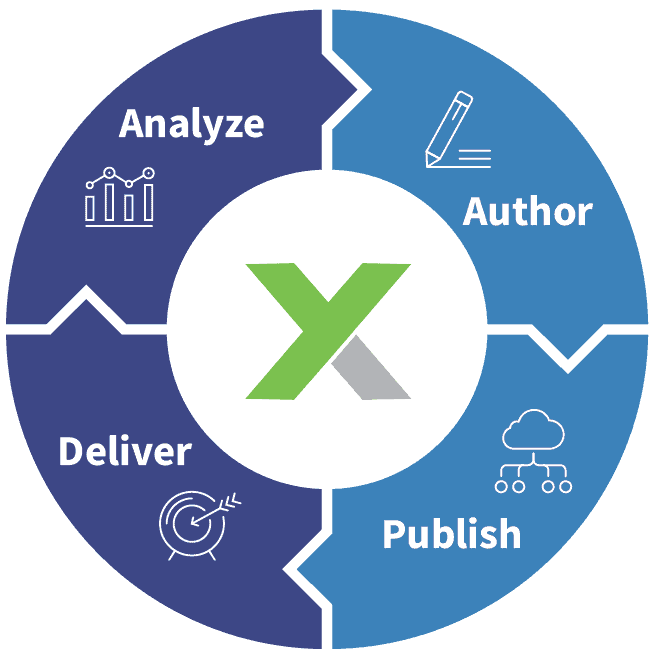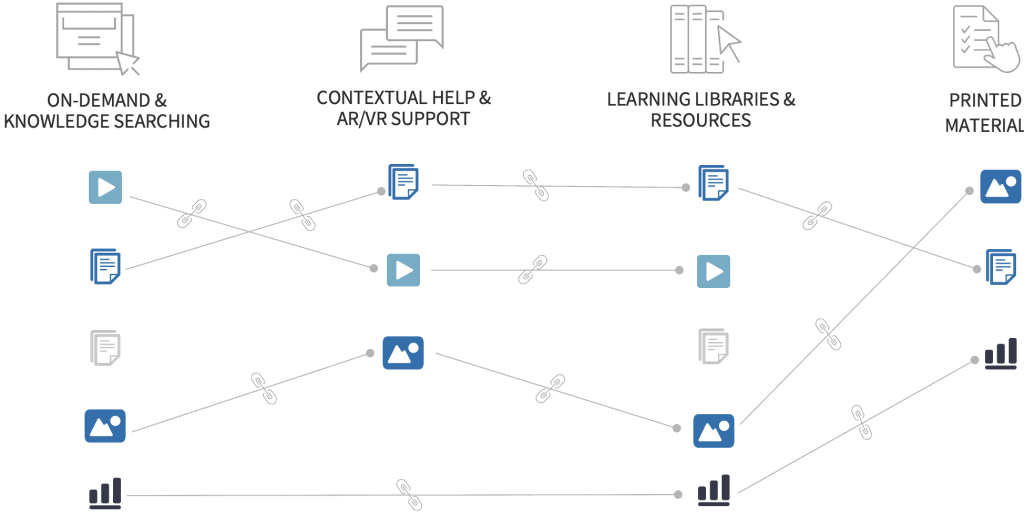The holiday season is upon us, and with it comes the spirit of giving and new beginnings. As we approach the end of 2023, it’s time for enterprise SaaS Learning and Development teams to start planning their budget asks for the upcoming year.
With the rapid pace of technology and changing workplace dynamics, it’s essential for organizations to prioritize continuous learning and development for their employees. And what better way to do so than by incorporating a Learning Content Management System into their budget asks for 2024? This powerful tool seamlessly integrates learning and development content into the flow of work, making it easier than ever to promote growth and development within the workforce.
So, let’s jingle all the way to improved learning and development with a Learning Content Management System in 2024!
Unwrapping the Concept: What is a Learning Content Management System?
When it comes to training and development in the workplace, having a solid content strategy is key. But how do you ensure that your learning materials are easily accessible, up-to-date, and seamlessly integrated into your employees’ workflow? That’s where a Learning Content Management System (LCMS) comes in.
An LCMS is a powerful tool that allows organizations to efficiently manage their learning content. It serves as a centralized hub where training materials, such as videos, e-learning modules, and documents, can be stored, organized, and updated. This ensures that employees have easy access to the most relevant and current resources, eliminating the frustration of searching through outdated materials or relying on scattered content silos.
But an LCMS is more than just a content repository. It also provides features that enhance the learning experience, such as version control. With an LCMS, you can track and manage different versions of your learning materials, making it easier to make updates and ensure that employees are always accessing the most recent and accurate information.
In addition, an LCMS allows organizations to leverage granular learning data. By capturing detailed information about how employees engage with the content, you can gain valuable insights into their learning preferences, strengths, and areas for improvement. This data can then be used to personalize and optimize future training and development initiatives.

Dealing with Disarray: Overcoming the Challenge of Content Silos in Learning and Development
In the world of Learning and Development, one of the biggest challenges organizations face is the disarray caused by content silos. With a multitude of learning materials scattered across different platforms and systems, it can be incredibly frustrating for employees to find the information they need when they need it. This disorganization can hinder productivity, hinder the learning experience, and ultimately hinder the overall growth and development of employees.
That’s where a Learning Content Management System (LCMS) comes in to save the day. By implementing an LCMS, organizations can overcome the challenge of content silos and bring order to the chaos. An LCMS serves as a centralized hub for all learning content, allowing organizations to create a cohesive content strategy and ensure that employees have easy access to the materials they need.
With an LCMS, organizations can break down the barriers created by content silos and streamline the learning process. By storing all learning materials in one place, employees no longer have to waste time searching through multiple platforms or systems to find what they need. Instead, they can simply log into the LCMS and access all relevant learning content in one convenient location.
Furthermore, an LCMS provides organizations with the ability to organize and categorize their learning materials in a way that makes sense for their specific needs. Whether it’s by topic, department, or job role, an LCMS allows organizations to create a structured and intuitive learning environment that promotes efficient and effective learning.
Navigating the Nutcracker Suite: Improving Version Control with a Learning Content Management System
As we continue unwrapping the concept of a Learning Component Management System (LCMS), let’s dive into one of its key benefits: improving version control. In the world of learning and development, keeping learning materials up-to-date is crucial for the success of any training program. However, without a centralized system in place, maintaining version control can become a real challenge. That’s where an LCMS comes to the rescue.
With an LCMS, organizations can effortlessly navigate the nutcracker suite of content management. By implementing a robust content strategy within the system, organizations can easily track and manage different versions of their learning materials. No longer will you have to worry about outdated content floating around, causing confusion among your learners. Instead, you’ll have complete control over the content, ensuring that your employees are always accessing the most recent and accurate information.

But the benefits of improved version control go beyond just keeping content up-to-date. It also allows organizations to make updates and revisions more efficiently. With an LCMS, making changes to your learning materials is a breeze. Whether it’s fixing a typo, updating a procedure, or incorporating new industry insights, you can easily edit and publish new versions of your content. This streamlines the process and ensures that your learners have access to the most relevant and valuable information.
In addition, an LCMS allows organizations to easily track the history of their learning materials. This can be especially valuable when it comes to compliance training or maintaining regulatory standards. With an LCMS, you can easily demonstrate that employees have received and completed the most recent version of required training. This level of accountability not only ensures compliance but also boosts the confidence of your organization’s stakeholders.
So, when it comes to navigating the nutcracker suite of version control, an LCMS is the ultimate companion. With its centralized hub, efficient content strategy, and easy update capabilities, you can ensure that your learning materials are always in tune with the latest knowledge and industry standards. Stay tuned as we continue our journey through the benefits of a Learning Content Management System.
Glittering Insights: Leveraging Granular Learning Data With A Learning Content Management System
When it comes to learning and development, insights are like little pieces of glitter that can transform your training programs into something truly spectacular. And with an lCMS in your arsenal, you can leverage granular learning data to unlock these glittering insights.
An LCMS captures detailed information about how employees engage with the learning content. From the number of times a module is accessed to the time spent on each page, you can gather valuable data that sheds light on individual learning preferences, strengths, and areas for improvement. This level of insight allows you to personalize and optimize future training initiatives, tailoring them to the unique needs and learning styles of your employees.
But the power of granular learning data doesn’t stop there. It also enables you to measure the effectiveness of your training programs. By analyzing metrics such as completion rates, quiz scores, and performance outcomes, you can assess the impact of your learning initiatives and make data-driven decisions for continuous improvement.
Additionally, granular learning data provides you with the ability to identify knowledge gaps and areas of high proficiency within your workforce. This knowledge can be invaluable for talent management and succession planning, helping you identify individuals who are ready for new challenges and growth opportunities.
Watch the webinar, Why Transparency in Data is Crucial for Content Success and and explore how data plays a pivotal role in measuring performance, uncovering improvement areas, fostering employee engagement, and delivering tailored learning experiences.
Building Bridges Not Walls: How a Learning Content Management System Facilitates Tech Stack Integration
As we continue our journey through the benefits of a Learning Component Management System, let’s explore how it can bridge the gap between different systems in your learning tech stack. In today’s fast-paced digital landscape, organizations often rely on a variety of tools and platforms to deliver learning and development initiatives. However, these disparate systems can create walls that hinder seamless integration and collaboration.
Enter the LCMS, your ultimate bridge builder. With its robust capabilities, an LCMS can seamlessly integrate with other systems in your tech stack, such as your Learning Management System (LMS) or Learning Experience Platform (LXP). This integration eliminates the need for manual data transfers and ensures that your learning content is easily accessible to employees, no matter where they are in the organization.
But the benefits of tech stack integration don’t stop there. By connecting your LCMS with other systems, you can leverage existing data to personalize the learning experience. For example, you can use employee performance data from your HRIS to recommend targeted training modules or tailor learning pathways based on specific job roles or career goals.
Furthermore, integrating your LCMS with other tools allows for seamless tracking and reporting of learning activities. This enables you to gather comprehensive data on learner engagement, completion rates, and performance outcomes, giving you valuable insights into the effectiveness of your learning programs.

Making a List, Checking It Twice: Simplifying Content Search, Update, and Maintenance
When it comes to managing learning content, keeping track of what you have and ensuring it’s up to date can feel like a never-ending task. But fear not, because with a Learning Content Management System (LCMS), you can simplify content search, update, and maintenance, making it a breeze to stay organized and efficient.
With an LCMS, you can create a centralized hub for all your learning materials. No more searching through scattered platforms or systems to find what you need. Instead, you can make a list of your content, check it twice, and have easy access to everything in one convenient location.
Not only does an LCMS streamline content search, but it also simplifies content update and maintenance. Need to make a quick edit or add new information? No problem! With an LCMS, you can easily update your learning materials and publish new versions with just a few clicks. This ensures that your employees are always accessing the most accurate and relevant information.
And let’s not forget about maintenance. With an LCMS, you can easily track and manage your learning content, making it simple to retire outdated materials or refresh content that may have become stale. This proactive approach to content maintenance ensures that your learning materials are always fresh and engaging.
Ringing in the Budget Asks for 2024: Why You Need to Include a Learning Content Management System
‘Tis the season to plan for the future, and as we approach the end of 2023, it’s time for enterprise SaaS Learning and Development teams to start thinking about their budget asks for 2024. If you want to make sure your organization is set up for success in the coming year, then including a LCMS in your budget is a must.
Why, you ask? Well, let’s unwrap the benefits. With an LCMS, you can say goodbye to the frustration of content silos and hello to a streamlined and organized learning experience. No more wasting time searching for materials scattered across different platforms. With an LCMS, all your learning content is centralized, making it easily accessible to employees.
But it doesn’t stop there. An LCMS also improves version control, ensuring that your employees are always accessing the most up-to-date and accurate information. You can easily make updates and revisions to your learning materials, keeping them in tune with the latest knowledge and industry standards.
And let’s not forget about the power of granular learning data. An LCMS allows you to capture detailed information about how employees engage with the content, giving you valuable insights into their learning preferences and areas for improvement. This data can be used to personalize and optimize future training initiatives.
Last but not least, an LCMS facilitates tech stack integration, bridging the gap between different systems in your learning ecosystem. With seamless integration, you can leverage existing data to personalize the learning experience and easily track and report on learning activities.
So, as you ring in the budget asks for 2024, don’t forget to include a Learning Component Management System. It’s the gift that keeps on giving, empowering your organization to deliver impactful and effective learning experiences that drive growth and development.






